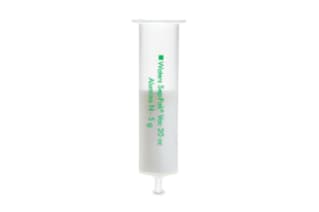
|
UNSPSC |
41115712 |
|
Brand |
Sep-Pak |
|
Product Type |
Solid Phase Extraction |
|
Units per Package |
20 pk |
|
Chemistry |
Alumina N |
|
Format |
Vac Cartridge |
|
Mass Spec Compatibility |
Yes |
|
Mode |
Normal-phase |
|
Particle Size |
50 - 300 µm |
|
Pore Size |
120 Å |
|
Sorbent Substrate |
Alumina |
|
Sorbent Weight |
5 g |
|
Water Wettable |
Yes |
|
pH Range Min |
0 pH |
|
pH Range Max |
10 pH |
|
Barrel Size |
20 cc |
|
Hold up volume |
3.9 mL |
Sep-Pak Alumina N 20 cc Vac Cartridge, 5 g Sorbent per Cartridge, 50 - 300 µm, 20/pk
Sep-Pak Alumina N An extremely active grade of alumina with neutral surface chemistry is found in vacuum cartridges. A very polar surface for analyte retention is provided by the aluminum oxide surface, which also possesses Lewis acid-like characteristics. While it functions in a manner comparable to silica, this normal-phase sorbent is somewhat more stable than silica, which has not been functionalized. For uses like fractionating synthetic crude oil, this neutral alumina is appropriate. For use with vacuum manifolds and automated SPE devices, these syringe-barrel-style cartridges are created.
Depending on how the sorbent's surface has been modified, alumina can be found in three different forms: Alumina A, Alumina B, and Alumina N. The pi-electrons of aromatic hydrocarbons interact specifically with alumina. Because of this, it is ideal for tasks like fractionating crude oil. Depending on your needs, acidic and basic grades can be used as low-capacity ion exchangers in aqueous mediums that are unaffected by high-energy radioactivity.
A male/male adaptor can be used to quickly and simply connect the Sep-Pak Alumina N Classic Cartridge to vacuum-assisted flow devices. It is designed to be used with a Luer-tip syringe that uses positive displacement. Certified Sep-Pak Alumina N cartridges are put through quality control to ensure repeatable separations. The cartridges provide greater performance for ultra-low-level analyte detection by reducing the chance of background interferences, which are frequently present in SPE devices.
Sep-Pak columns with "Neutral" sorbent and normal phase can be used with the Sep-Pak Alumina N Classic Cartridge. There are several uses for the Sep-Pak Alumina phase. Just a few applications include conducting analyses on synthetic organic compounds, pesticides, herbicides, priority pollutant isolation, and substitutes for conventional AOAC and EPA techniques. They can support volumes up to 1.8 mL with particle sizes of 50-300 µm, 120 pore size, and 1850 mg of sorbent per cartridge.
Check out our website to shop for lab equipment and locate complementary items to your existing set. You might want to look into TruView LCMS Certified Clear Glass 12 x 32 mm Screw Neck Vial, with Cap and Preslit PTFE/Silicone Septum, 2 mL Volume, 100/pk; Vials that are TruView LCMS Certified are made using strictly regulated manufacturing and handling techniques. Mass spectrometers are used to check for cleanliness, and ACQUITY/MS/MS is used to check for low analyte adsorption.
What Is Meant by HPLC?
The analytical technique known as high-performance liquid chromatography, or HPLC, is used to separate, recognize, and quantify mixture components. The most common process used in laboratories around the world, this test is used for a variety of purposes.